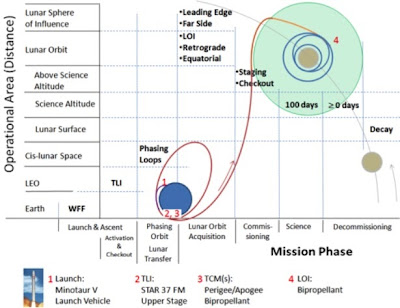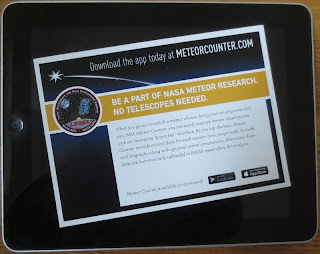LADEE, the Lunar Atmosphere and Dust Environment Explorer is a robotic lunar orbiter that will fly into the moon's atmosphere to sample its composition and structure and look for dust lofted into the lunar sky. Determine the size, charge, and spatial distribution of electro-statically transported dust grains? She's on it!
During LADEE's time over the surface-boundary exosphere (an atmosphere that is so thin and tenuous that molecules don't collide with each other), her UV Spectrometer will determine the global density, composition, and spatial variability of the fragile lunar atmosphere before it is perturbed by future human activity.
It may also shed light on the atmospheric species 20-150 kilometers above the lunar surface. Are these species at orbital altitudes there by virtue of solar wind? Released from lunar soil? Can we discover the cycles and sources of these species? LADEE may tell us!
I think the most exciting portion of the mission will be the optical communications experiments. While in orbit, it will demonstrate the first 2-way high-rate long-range laser communications. The Lunar Laser Communications Demonstration (LLCD) will test how spacecraft may be able to use lasers to send movies, high-resolution photographs and even 3D images to ground controllers, someday
LADEE launched yesterday evening from NASA Wallops Flight Facility in Virginia, though over 8,000 west-coasters also watched the launch event at an epic party at NASA Ames Research Center
And now now that LADEE is flying, NASA needs your help!
During the LADEE Mission, NASA would like to have as many people as possible submitting meteor counts so scientists can compare that data to what LADEE's instruments record. And of course, there's an app for that.
Download the NASA Meteor Counter app, which allows observers to use their iPhones, iPads, or Androids to record meteor count observations, and send the data directly to NASA.
When you watch a meteor shower, just take your smart phone with you! (As if you leave it home anyway, right?) Capture meteors with the "piano key" interface. As you tap the keys, Meteor Counter records critical data for each meteor: time, magnitude, latitude and longitude, along with optional verbal annotations. These data are uploaded to researches at NASA for analysis.
Anothe great way to get involved is with your 8 to 14-inch aperture telescope to detect meteoroid impacts, as monitored by the NASA Meteoroid Environment Office, and the Lunar Impact Monitoring Program. In both entities, lunar scientists seek to determine the rate of meteoroid impacts on the Moon, as they are an important source for the lunar exosphere and dust.
The LADEE mission is a also a participant in the International Observe the Moon Night, and the Student Spacecraft Tracking and Monitoring effort, so visit LADEE Mission Opportunities page to pick a project!








